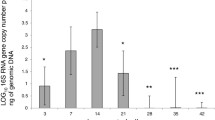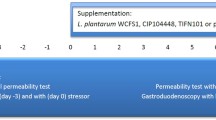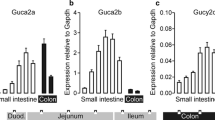Abstract
Expression of Tlr2, Defa, and Muc2 genes in epithelial cells of rat duodenum during prolonged stomach hypoacidity (hypochlorhydria) and after hypoacidity correction by multiprobiotics has been investigated. Elevation of Tlr2, Muc2, and Defa gene expression levels upon the intensification of lipid peroxidation processes in the epithelial cells of the villi and crypts of the rat duodenum under hypoacidic conditions has been demonstrated. Administration of a multiprobiotic under the same conditions downregulated the expression of the aforementioned genes in epithelial cells of the villi and crypts, bringing it to a nearly normal level, and exerted a similar effect on the levels of lipid peroxidation products. The data obtained may be indicative of the involvement of Tlr2, Muc2, and Defa genes in the development of duodenal inflammation induced by dysbiotic changes occurring in prolonged hypochlorhydria.
Similar content being viewed by others
References
Kobayashi, K.S., Chamaillard, M., Ogura, Y., Henegariu, O., Inohara, N., Nucez, G., and Flavell, R.A., Nod2-dependent regulation of innate and adaptive immunity in the intestinal tract, Science, 2005, vol. 307, no. 5710, pp. 731–734.
Lisitsyn, N.A., Bukurova, Y.A., Nikitina, I.G., Krasnov, G.S., Sykulev, Y., and Beresten, S.F., Enteric alpha defensins, in norm and pathology, Ann. Clin. Microbiol. Antimicrob., 2012, vol. 11, p. 1.
Dvorshchenko, K.O., Bernyk, O.O., Dranitsina, A.S., Senin, S.A., and Ostapchenko, L.I., Influence of oxidative stress on the level of genes expression TGFB1 and HGF in rat liver upon long-term gastric hypochlorhydria and administration of multiprobiotic Symbiter, Ukr. Biochem. J., 2013, vol. 85, no. 5, pp. 114–123 (in Ukrainina).
Shin, J.M., Vagin, O., Munson, K., Kidd, M., Modlin, I.M., and Sachs, G., Molecular mechanisms in therapy of acid-related disease, Cell Mol. Life Sci., 2008, vol. 65, no. 2, pp. 264–281.
Johnson, D.A. and Oldfield, E.C., Reported side effects and complications of long-term proton pump inhibitor use. Dissecting the evidence, Clin. Gastroenterol. Hepatol., 2013, vol. 11, no. 5, pp. 458–464.
Johnson, L.R., Barrett, K.E., Gishan, F.K., Merchant, J.L., Said, H.M., and Wood, J.D., Physiology of the Gastrointestinal Tract, 4th ed., New York: Acad. Press, 2006.
Thomson, A., Sauve, M., Kassam, N., and Kamitakahara, H., Safety of long-term use of proton pump inhibitors, World J. Gastroenterol., 2010, vol. 16, no. 19, pp. 2323–2330.
Zhang, R., Brennan, M.L., Shen, Z., MacPherson, J.C., Schmitt, D., Molenda, C.E., and Hazen, S.L., Myeloperoxidase functions as a major enzymatic catalyst for initiation of lipid peroxidation at sites of inflammation, J. Biol. Chem., 2002, vol. 277, no. 48, pp. 46116–46122.
Frolova, L., Drastich, P., Rossmann, P., Klimesova, K., and Tlaskalova-Hogenova, H., Expression of Toll-like receptor 2 (TLF2), TLR4, and CD14 in biopsy samples of patients with inflammatory bowel diseases: upregulated expression of TLR2 in terminal ileum of patients with uncreative colitis, J. Histochem. Cytochem., 2008, vol. 56, no. 3, pp. 267–274.
Erridge, C., Endogenous ligands of TLR2 and TLR4: agonists or assistants?, J. Leukoc. Biol., 2010, vol. 87, no. 6, pp. 989–999.
McMahon, L.A., House, A.K., Catchpole, B., Elson-Riggins, J., Riddle, A., Smith, K., Werling, D., Burgener, I.A., and Allenspach, K., Expression of Toll-like receptor 2 in duodenal biopsies from dogs with inflammatory bowel disease is associated with severity of disease, Vet. Immunol. Immunopathol., 2010, vol. 135, nos. 1–2, pp. 158–163.
Burgener, I.A., König, A., Allenspach, K., Sauter, S.N., Boisclair, J., Doherr, M.G., and Jungi, T.W., Upregulation of Toll-like receptors in chronic enteropathies in dogs, J. Vet. Intern. Med., 2008, vol. 22, no. 3, pp. 553–560.
Szebeni, B., Veres, G., Dezsxfi, A., Rusai, K., Vannay, Á., Mraz, M., Majorova, E., and Araty, A., Increased expression of Toll-like receptor (TLR) 2 and TLR4 in the colonic mucisa of children with inflammatory bowel disease, Clin. Exp. Immunol., 2008, vol. 151, no. 1, pp. 34–41.
Kim, Y.S. and Ho, S.B., Intestinal goblet cells and mucins in health and disease: recent insights and progress, Curr. Gastroenterol. Rep., 2010, vol. 12, no. 5, pp. 319–330.
Ikeda, H., Sasaki, M., Ishikawa, A., Sato, Y., Harada, K., Zen, Y., Kazumori, H., and Nakanuma, Y., Interaction of Toll-like receptors with bacterial components induces expression of CDX2 and MUC2 in rat biliary epithelium in vivo and in culture, Lab. Invest., 2007, vol. 87, no. 6, pp. 669–571.
McGuckin, M.A., Linden, S.K., Sutton, P., and Florin, T.H., Mucin dynamics and enteric pathogens, Nat. Rev. Microbiol., 2011, vol. 9, no. 4, pp. 265–278.
Yu, J., Hao, X., Long, M., Wang, Q., Qu, Y., Wen, Y., Zhang, W., Luo, J., and Cao, H. Role of MUC2 gene in the regulation of rat intestinal barrier function by probiotics, Nan Fang Yi Ke Da Xue Xue Bao, 2013, vol. 33, no. 2, pp. 197–201.
Wang, T., Liang, Y.M., Hu, P., and Chen, Y.F., Mucins differently expressed in various ampullary adenocarcinomas, Diagn. Pathol., 2011, vol. 6, no. 102, pp. 1–8.
Joo, M., Shahsafaei, A., and Odze, R.D., Paneth cell differentiation in colonic epithelial neoplasms: evidence for the role of the Apc/beta-catenin/Tcf pathway, Hum. Pathol., 2009, vol. 40, no. 6, pp. 872–880.
Culligan, E.P., Hill, C., and Sleator, R.D., Probiotics and gastrointestinal disease: successes, problems and future prospects, Gut Pathog., 2009, vol. 1, no. 1, p. 19.
Iankovsky, D. and Dyment, G., Microbiota and Human Health, Kyiv: LLC Chernova Ruta-Turs, 2008.
Tsyriuk, O.I. and Beregova, T.V., Effect of omeprazoleinduced hypergastrinemia on the basal gastric secretion in rats, Bull. Biol. Med., 2007, no. 3, pp. 38–43.
Gavrilov, V.B., Gavrilova, A.R., and Khmara, N.F., Measurement of conjugated diene in plasma by UV absorbance and heptane nzopropa-phenolic extracts, Laboratory Work, 1988, no. 2, pp. 60–63.
Kolesov, O.E., Markin, A.A., and Fedorova, T.N., Lipid peroxidation and methods for the determination of lipid peroxidation products in biological samples, Laboratory Work, 1984, no. 9, pp. 540–546.
Stalnaya, I.D. and Garishvili, T.G., Method for determination of malondialdehyde using thiobarbituric acid, in Modern Methods in Biochemistry, Moscow: Medicine, 1977, pp. 66–68.
Lowry, O.H., Rosenbrough, N.J., Farr, A.L., and Randall, R.I., Protein measurement with the Folin phenol reagent, J. Biol. Chem., 1951, vol. 193, no. 1, pp. 265–275.
Flint, N., Cove, F.L., and Evans, G.S., A low-temperature method for the isolation of small-intestinal epithelium along the crypt-villus axis, Biochem. J., 1991, vol. 280 (pt. 2), pp. 331–334.
Chomczynski, P. and Sacchi, N., Single-step method of RNA isolation by acid guanidinium thiocyanatephenol-chloroform extraction, Anal. Biochem., 1987, vol. 162, no. 1, pp. 156–159.
Green, M.R. and Sambrook, J., Molecular Cloning: A Laboratory Manual, 4th ed., New York: Cold Spring Harbor Lab. Press, 2012.
Konturek, P.C., Brzozowski, T., Walter, B., Burnat, G., Hess, T., Hahn, E.G., and Konturek, S.J., Ghrelininduced gastroprotection against ischemia-reperfusion injury involves an activation of sensory afferent nerves and hyperemia mediated by nitric oxide, Eur. J. Pharmacol., 2006, vol. 536, nos. 1–2, pp. 171–181.
Dvorshchenko, K.O., Savko, U.V., and Ostapchenko, L.I., Impact of multiprobiotic Cymbiter on free radical processes in duodenal epitheliocytes in conditions of longterm gastric hypochlorhydria, Exp. Clin. Physiol. Biochem., 2013, vol. 1, no. 61, pp. 85–90.
Ghosh, C. and Bishayi, B., Characterization of Toll-Like receptor-4 (TLR-4) in the spleen and thymus of Swiss albino mice and its modulation in experimental endotoxemia, J. Immunol. Res., 2015, vol. 2015, pp. 1–13.
Lutgendorff, E., Trulsson L.M., van Minnen, L.P., Rijkers, G.T., Timmerman, H.M., Franzén, L.E., Gooszen, H.G., Akkermans, L.M., Söderholm, J.D., and Sandström, P.A., Probiotics enhance pancreatic glutathione biosynthesis and reduce oxidative stress in experimental acute pancreatitis, Am. J. Physiol. Gastrointest. Liver Physiol., 2008, vol. 295, no. 5, pp. 1111–1121.
Author information
Authors and Affiliations
Corresponding author
Additional information
Original Russian Text © A.S. Dranitsina, K.O. Dvorshchenko, O.O. Morgaienko, D.M. Grebinyk, L.I. Ostapchenko, 2016, published in Tsitologiya i Genetika, 2016, Vol. 50, No. 3, pp. 57–65.
About this article
Cite this article
Dranitsina, A.S., Dvorshchenko, K.O., Morgaienko, O.O. et al. Expression of Tlr2, Defa, and Muc2 genes in rat duodenum epithelial cells during prolonged stomach hypoacidity and after hypoacidity correction by multiprobiotics. Cytol. Genet. 50, 196–202 (2016). https://doi.org/10.3103/S009545271603004X
Received:
Published:
Issue Date:
DOI: https://doi.org/10.3103/S009545271603004X




